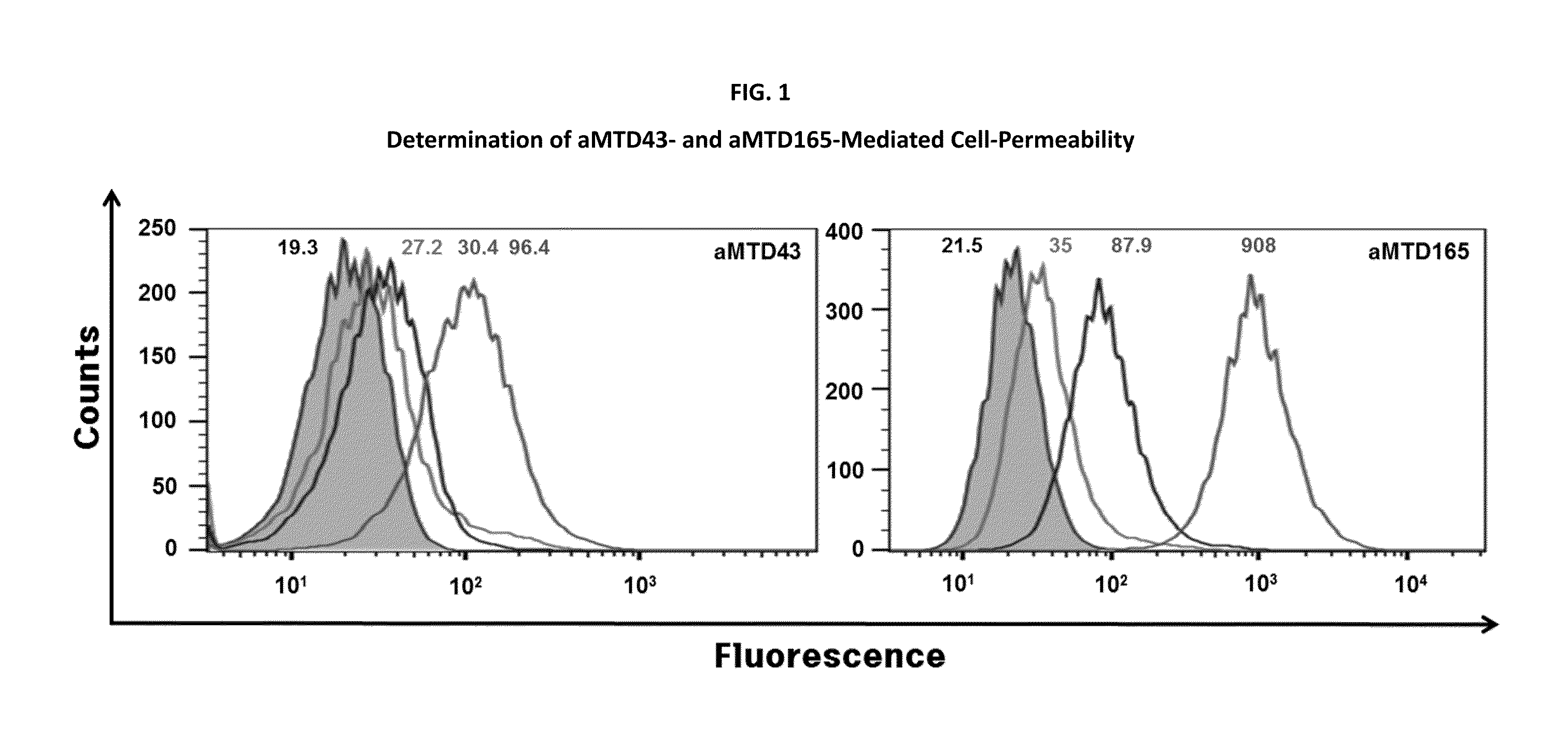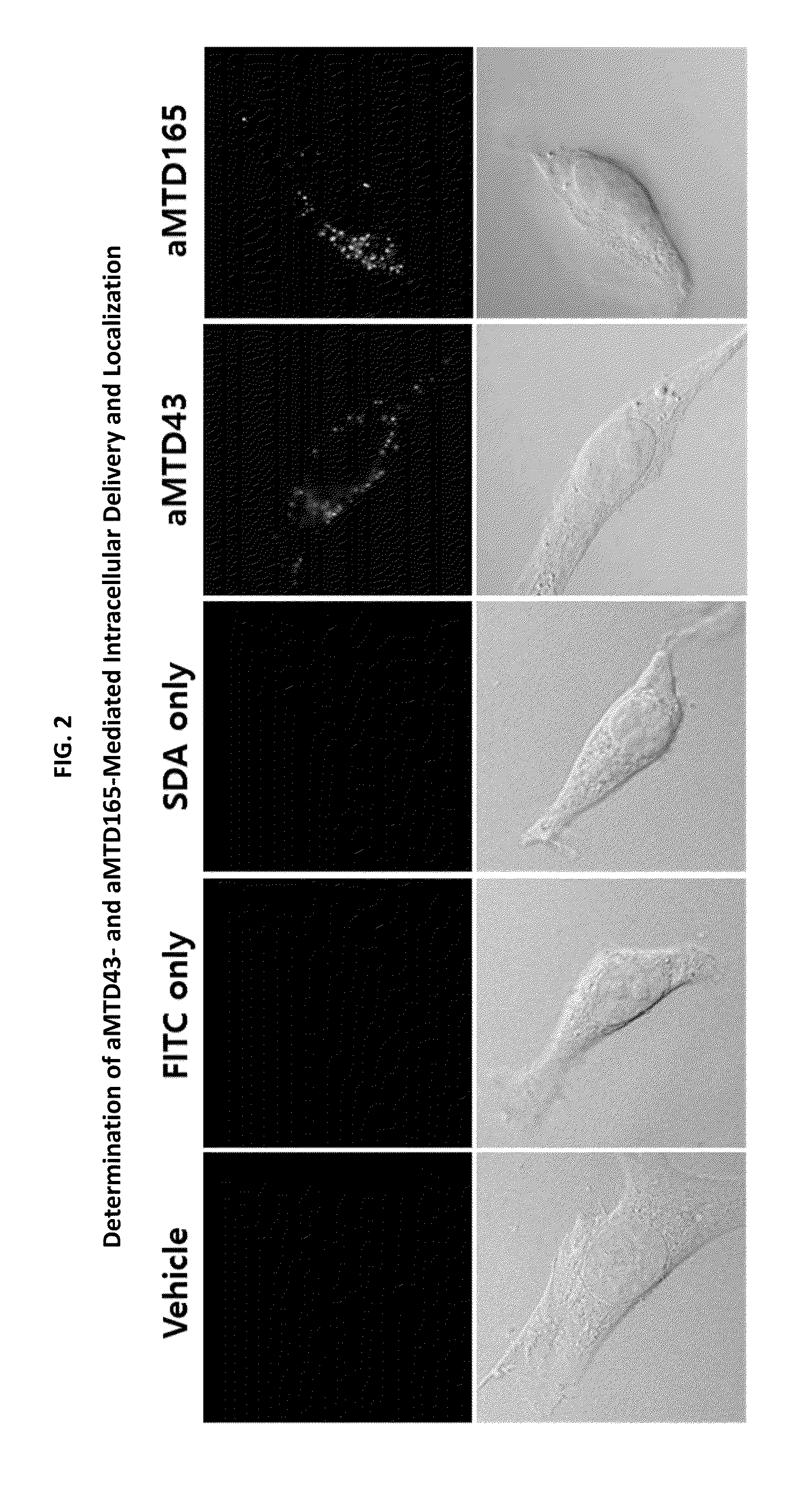Development of Protein-Based Biotherapeutics That Penetrate Cell-Membrane and Induce Anti-Cancer Effect - Cell-Permeable Trefoil Factor 1 (CP-TFF1) in Gastrointestinal Track (GIT) Cancer, Polynucleotides Encoding The Same, and Anti-Cancer Compositions Comprising The Same
a technology of gastrointestinal track and git cancer, which is applied in the field of protein-based biotherapeutics, can solve the problems of poor yield, low cell- and tissue-permeability, and difficult systemic protein delivery in animals, and achieve the effects of improving solubility/yield, cell-/tissue-permeability and anti-gastric cancer effects
- Summary
- Abstract
- Description
- Claims
- Application Information
AI Technical Summary
Benefits of technology
Problems solved by technology
Method used
Image
Examples
example 1
Construction of Expression Vectors for TFF1 Recombinant Proteins Fused to aMTDs
[0084]The expression vectors were designed for TFF1 recombinant protein fused with either one or both SDs (SDA, SDB, SDC, and SDD) and aMTD43 or aMTD165. To acquire expression vectors for TFF1 recombinant proteins, polymerase chain reaction (PCR) had been devised to amplify each designed aMTD43 or aMTD165 fused with TFF1.
[0085]The PCR reactions (100 ng genomic DNA, 10 pmol each primer, each 0.2 mM dNTP mixture, 1× reaction buffer and 2.5 U Pfu(+) DNA polymerase (Doctor Protein, Korea)) was digested on the different restriction enzyme site involving 40 cycles of denaturation (95° C.), annealing (58° C.), and extension (72° C.) for 30 seconds each. For the last extension cycle, the PCR reactions remained for 10 minutes at 72° C. TFF1 recombinant protein clones were produced in three sets. Set 1 coding sequence for SDA or SDB fused to C terminus of his-tagged aMTD / SD-TFF1 was cloned at NdeI (5′) and SalI (3′...
example 2
Purification and Preparation of aMTD / SD-Fused TFF1 Recombinant Protein
[0086]Denatured recombinant proteins were lysed using denature lysis buffer (8 M Urea, 10 mM Tris, 100 mM NaH2PO4) and purified by adding Ni-NTA resin. Resin bound to proteins were washed 3 times with 30 mL of denature washing buffer (8 M Urea, 10 mM Tris, 20 m imidazole, 100 mM NaH2PO4). Proteins were eluted 3 times with 30 mL of denature elution buffer (8 M Urea, 10 mM Tris, 250 mM imidazole). After purification, they was dialyzed twice against a refolding buffer (550 mM Guanidine-HCl, 440 mM L-Arginine, 50 mM Tris, 100 mM NDSB, 150 mM NaCl, 2 mM reduced glutathione and 0.2 mM oxidized glutathione). Finally, they were dialyzed against a physiological buffer such as DMEM at 4° C. until the dialysis was over 300×105 times. Concentration of purified proteins was quantified using Bradford assay according to the manufacturer's instructions. After purification, they were dialyzed against DMEM as indicated above. Final...
example 3
Determination of Cell-Permeability of aMTD / SD-Fused TFF1 Recombinant Proteins
[0089]For quantitative cell-permeability, the aMTD-fused recombinant proteins were conjugated to FITC according to the manufacturer's instructions (Sigma-Aldrich, St. Louis, Mo.). RAW 264.7 cells were treated with 10 μM FITC-labeled recombinant proteins for 1 hour at 37° C., washed three times with cold PBS, and treated with proteinase K (10 μg / mL) for 5 minutes at 37° C. to remove cell surface-bound proteins. Cell-permeability of these recombinant proteins were analyzed by flow cytometry (Guava, Millipore, Darmstadt, Germany) using the FlowJo cytometric analysis software.
PUM
| Property | Measurement | Unit |
|---|---|---|
| Fraction | aaaaa | aaaaa |
| Time | aaaaa | aaaaa |
| Molar density | aaaaa | aaaaa |
Abstract
Description
Claims
Application Information
 Login to View More
Login to View More - R&D
- Intellectual Property
- Life Sciences
- Materials
- Tech Scout
- Unparalleled Data Quality
- Higher Quality Content
- 60% Fewer Hallucinations
Browse by: Latest US Patents, China's latest patents, Technical Efficacy Thesaurus, Application Domain, Technology Topic, Popular Technical Reports.
© 2025 PatSnap. All rights reserved.Legal|Privacy policy|Modern Slavery Act Transparency Statement|Sitemap|About US| Contact US: help@patsnap.com



